It’s been almost six months since my last set of book reviews, and scattered between all the mystery, sci-fi, fantasy, and history books I’ve read in that time, I’ve managed another ten related to food and cooking.
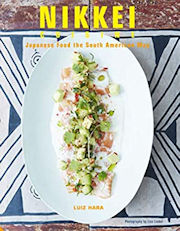 Nikkei Cuisine by Luiz Hara Nikkei Cuisine by Luiz Hara
Upfront, I’d note that I read the Spanish version of this, Cocina Nikkei, so I’m making somewhat of an assumption that the content and prose are more or less the same. I’m sure there’s some variation just based on the translator, but I’d hope that the gist of the book stays intact. Obviously, anyone who knows me or reads these pages, knows I’m not only fascinated by Peruvian cuisine, but in particular by some of the modern fusion versions, like nikkei cooking, which is the Japanese-Peruvian style that’s sort of taking the world on these days. This particular book is more focused on recipes than anything else, but there’s a decent amount of history, and personal story, to make it very readable as well. The recipes themselves seem to have been well tested, they’re easy to follow (at least from a chef’s perspective, but I saw little that I would think a good home cook would have any difficulty following), and sound delicious. I have yet to try any out of the book, but they make my mouth water when I read them, and that’s pretty much the goal of most cookbooks! ***** 5/5 |
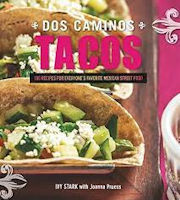 Dos Caminos Tacos: 100 Recipes for Everyone’s Favorite Mexican Street Food by Ivy Stark & Joanna Pruess Dos Caminos Tacos: 100 Recipes for Everyone’s Favorite Mexican Street Food by Ivy Stark & Joanna Pruess
Another one that’s primarily recipes, a cookbook. I think I’d hoped for more to the story and background, but there’s enough there to certainly hold my interest through the book. The recipes, both traditional and modern takes on tacos and accompaniments are easy to follow, and sound absolutely delicious. The couple of things I’ve tried making from them have proven that out. My one real criticism that stops this from getting a fifth star is that it gets a bit repetitive at times – like there was a need to hit 100 recipes, and so let’s just change one or two ingredients on an already written one and call it a new one. Stuff like that could have easily been handled by just doing a one or two sentence note at the bottom of the first recipe saying, hey, you could use chicken and green onions instead of pork and red onions, or something to that effect. The book could just have easily been 80 Recipes for Everyone’s Favorite Mexican Street Food without losing any magic or cachet. **** 4/5 |
 Droppings From My Table by The Gastrician Droppings From My Table by The Gastrician
I have to admit to being unfamiliar both with the anonymous Gastrician and the magazine, Fire & Knives, a London-based quarterly. Is The Gastrician the publisher/editor of the magazine, Tim Hayward? I don’t know, I didn’t delve into it. This is a collection of his/her columns from the magazine. Well written, fun to read, and often satirical. Perhaps, the last, to a fault. There are moments when it seems like the satire, the smirk, the sneer, is there simply for effect, and neither relevant to the particular review, nor, perhaps, deserved by the restaurant in question. Doesn’t make it less fun, but perhaps less effective. **** 4/5 |
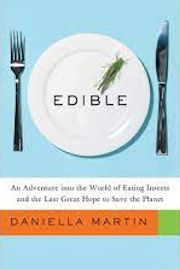 Edible: An Adventure into the World of Eating Insects and the Last Great Hope to Save the Planet by Daniella Martin Edible: An Adventure into the World of Eating Insects and the Last Great Hope to Save the Planet by Daniella Martin
We’ve all read about it in newspapers and magazines, and seen glimpses of it on TV. The coming wave of dietary change to incorporating insects into our daily fare. Many of us, in our travels, have sampled one or another “exotic delicacies”, which for those of us from cultures where insects are not considered a food source, feels daring, and perhaps a touch naughty. Echoes of parents’ admonitions, “Don’t put that in your mouth!” abound. This book aims to ease the average non-insectivore into that world with a light hearted yet well documented journey to kitchens and “farms” around the US. Bringing in the adventurous palates of kids who have not yet been indoctrinated to not eat such things is a nice touch, and it was easy to see their wonder and surprise in trying different snacks and dishes. Hey, it’s coming folks. Like it or not. **** 4/5 |
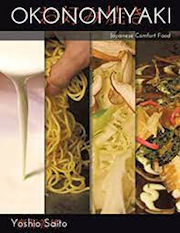 Okonomiyaki: Japanese Comfort Food by Yoshio Saito Okonomiyaki: Japanese Comfort Food by Yoshio Saito
There’s a certain inherent difficulty in approaching a single subject cookbook, both as a writer and a reader. Much like the taco tome above, you’re both doomed to some level of repetitiveness. You have to repeat certain basic instructions over and over again, you can’t have twelve recipes that tell someone to turn back to page 8 and follow the first four steps there and then come back to one of those dozen to continue on from there. But Saito does a good job just skating on the balance point between too much and too little, helped, no doubt, by the different styles and techniques of making these “Japanese crepe-pancakes” from various regions of Japan. He brings in enough story and background to keep it interesting, and keep it moving. He maybe lost me a little at some of the modern twists, but that’s my flaw, not his, and is no doubt a big part of the okonomiyaki world in modern day Japan. **** 4/5 |
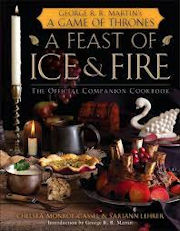 A Feast of Ice and Fire: The Official Game of Thrones Companion Cookbook by Chelsea Monroe-Cassel and Sariann Lehrer A Feast of Ice and Fire: The Official Game of Thrones Companion Cookbook by Chelsea Monroe-Cassel and Sariann Lehrer
I mean, this one gets points just for tackling a subject like this. Now I know not everyone is a Game of Thrones fan, and I’ve even tried to not dismiss the non-fans from my life, but this is a hard one. While George R.R. Martin throws in a lot of food descriptions and moments at the table, he’s not exactly giving ingredient lists or techniques (we’re talking the books here, not the TV series). The authors don’t let that stop them, and have managed to delve into what amounts to medieval English cooking and modern English cooking, and find a strangely satisfying balance. They speculate on classic dishes that come close to fitting the descriptions of what Martin meanders on about, try it out, present it, photograph it (beautifully I might add), and then in many of the cases, turn around and come up with a modern take on the same dish or ingredients, and do the same. The one drawback, in some ways, is the subject matter – though it may be my own failing, I don’t think there was a single recipe that enticed me to try making it – it felt like the kind of food one might make for a dinner party of fans of either the books or TV series, but probably for little other reason. **** 4/5 |
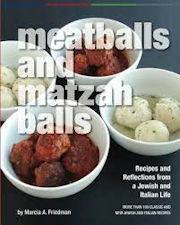 Meatballs and Matzah Balls: Recipes and Reflections from a Jewish and Italian Life by Marcia A. Friedman Meatballs and Matzah Balls: Recipes and Reflections from a Jewish and Italian Life by Marcia A. Friedman
Our fascination with food in modern day life has led to a glut of books that are wanders down memory lane for, sometimes it seems, every person who ever picked up a wooden spoon with the intent to stir a sauce. The problem is, that not everyone’s life is as interesting to the rest of the world as it is to themselves or their families and friends. So while I don’t wish to rain on Friedman’s parade, as it were, I found myself towards the end of this book sort of saying, “so what?” I appreciate she had a personal story to share, it just wasn’t one that resonated, it sounded like so many other stories that are already out there. Still, it was at least an interesting journey, and kept me going, it’s certainly well written – I didn’t toss the book aside. But for me, where it fell down, were the recipes. There are just too many other even better written Italian-Jewish cookbooks already out there, ones that have tackled this genre both in personal stories and in professional kitchens. The recipes in this book feel a little bit like diving into one of those old spiral bound church or synagogue social group recipe books that everyone in the congregation contributed to, and thinking, really…? *** 3/5 |
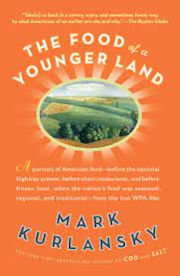 The Food of a Younger Land: The Middle West Eats Ohio, Indiana, Michigan, Minnesota, Wisconsin, Iowa, Nebraska, Kansas, Missouri, South Dakota, North Dakota by Mark Kurlansky The Food of a Younger Land: The Middle West Eats Ohio, Indiana, Michigan, Minnesota, Wisconsin, Iowa, Nebraska, Kansas, Missouri, South Dakota, North Dakota by Mark Kurlansky
Part of a series of ebooks curated by Kurlansky, this is an homage to the Federal Writers’ Project, what amounted to a make-work New Deal program in the FDR era. Writers from around the country were given assignments or volunteered to write about local food traditions in their own communities, and were paid for it – a way of getting at least a stipend into people’s pockets following the Great Depression. In any curated work, there’s going to be some unevenness, different writers have differing styles, quality of writing, and all the rest. Kurlansky has done an admirable job of picking out a good number of truly enjoyable essays, poems, and musings, and strung them together with his usual smart commentary. **** 4/5 |
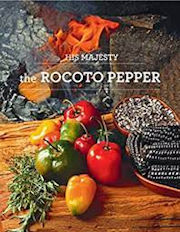 His Majesty the Rocoto Pepper by José Valdizán Ayala His Majesty the Rocoto Pepper by José Valdizán Ayala
This is another that I read in Spanish, not even realizing there was an English language version, as it’s basically an academic work out of Peru. A fascinating look at the origins, cultivation, and usages of what is arguably Peru’s favorite chili pepper, the rocoto. Ayala did a good job of making what could have been a very dry anthropological study into something eminently readable, enjoyable, and packed with beautiful photos and illustrations, and a quite good selection of traditional recipes from different regions of Peru. **** 4/5 |
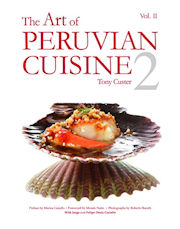 The Art of Peruvian Cuisine Vol. II, by Tony Custer The Art of Peruvian Cuisine Vol. II, by Tony Custer
The second volume in this excellent set. I’ve used volume I as a reference and inspirational book for years now and was delighted to find out that Custer has added a follow on volume that just extends the exploration of modern Peruvian cooking. Gorgeous photos, intricate but generally easy to follow recipes, for anyone who wants to read about, and try out, the modernization of traditional recipes, I’ve not seen a better book set. Plus, at least the Kindle version, proceeds go to a fund that supports the education of poorer children in Peru. ***** 5/5 |